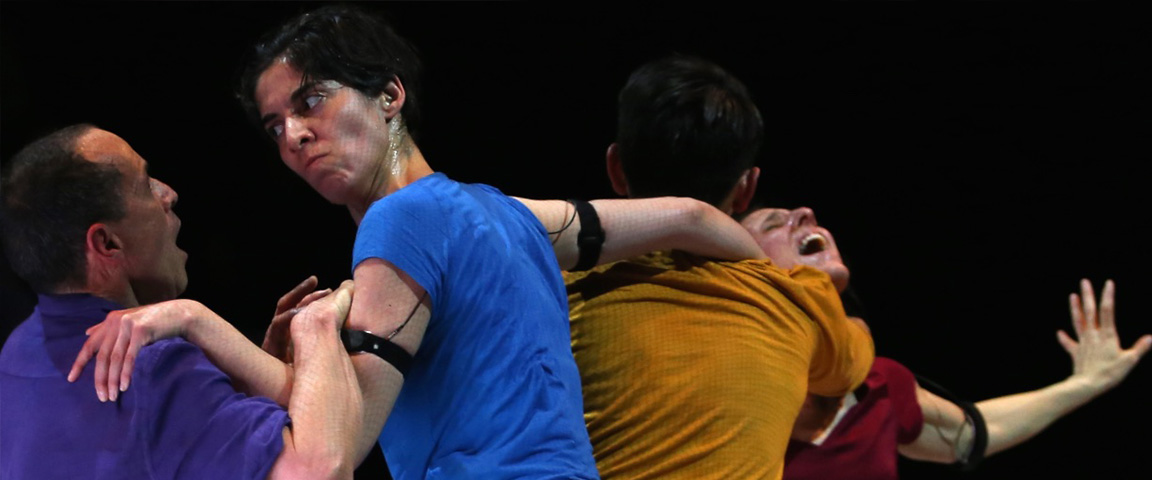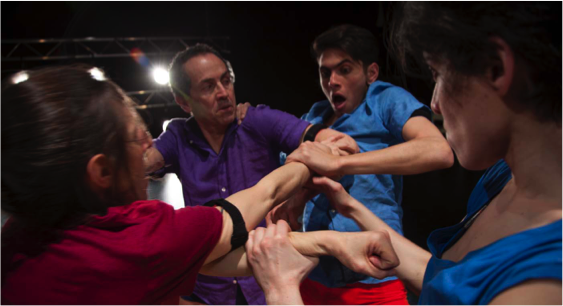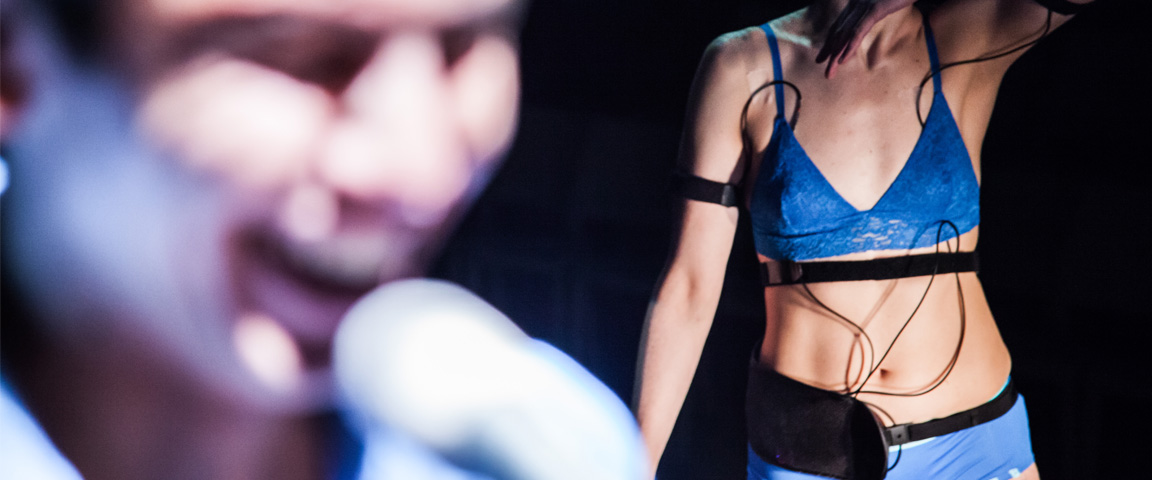The corporal material emerged from Alba Emoting had potential for creation due to the strength of each pure emotion and the deep holistic process in which the emotional experience placed us. The experience of emotion allowed us to be in a familiar world due to the universal nature of the explored emotions, while at the same time it disoriented us and drove us to find ourselves in actions and relationships where the body moved fully, without preconceptions and outside narrative contexts that justified the appearance of a specific emotion. Emotion is then presented as pure simplicity, as a materiality that is abstract and concrete at the same time, not as a consequence of the events or as a response to the representation of the relationships, and much less as comments on the human condition. This experience with pure emotion also placed the performance’s discursive form in a concrete field due to the possibility of recognizing the emotions presented, and also in an abstract field because it didn’t contain a narrative that justified its appearance.
The process of generating a movement language from sound interaction required the performer to have a bodily approach that was very different from the one provided in the emotional induction training, marked by the engagement of perceptive kinesthetic and listening skills as well as cognitive technological ones. From the beginning, this process was founded on a mainly functional period before achieving a development of the movement that was also expressive. The functional period implied consulting and exploring with the sensors in order to understand their use with dancers, exploration sessions with movement qualities based on concepts from the Laban theory, biofeedback experimentation with electromyograms, exploration and improvisation with a first interaction model (in layers[4]) and different sound objects. The novelty of the experience demanded a constant assessment of the process and an individualized application of the conclusions. The performers were exposed to an “embodyment”[5] process that required focused kinesthetic assistance in order to develop a more conscious and precise interactivity that allowed generating an expressive movement with relative control of the system. This relative control was permitted because it was associated with the voluntary movement system; however, the experience started to show that this “control” responded to a diversity of variables. This implied becoming familiar with a new vocabulary and being able to understand how the system works in order to have the ability to adjust in a particular manner according to personal body variables, in addition to the difficulties that arose in each session. From the beginning, the variability of the system pushed us to face a dynamic, ungraspable and elusive organicity, an aesthetics rooted in a system based on “biofeedback” [6].
The appearance of a richer, more complex expressive language was possible when the performers started to engage in a sensitive and simultaneous dialogue with the set of elements proposed by the interaction system. This required building movement relationships with the sound qualities of the objects designed, a devising that implied processes of perception, association, translation, abstraction and representation of the sound environment that the movement itself was generating. This individual generative process was founded on the processes of sensitive listening and intuitive and immediate response to the sound stimulus, which produced a series of mental processes with responses in emotional gestures, qualities, images and abstract narratives from which an expressive movement language proposal was organized and developed. Therefore, more than a response to the control or reaction process, this language was rather a sensitive dialogue with the entire system. This caused the entire body of the performer to become integrated without having to think about activating areas of the body that did not regulate the sound, but rather the body moved due to the construction of a movement that is the metaphor, representation and interpretation of the experience of feeling oneself, hearing oneself and having a dialogue with the stimuli that emerged when the sound environment was modulated. Then, this metaphor of the body generates a language that produces a sensitive, emotional and imaginative sense with the sound.
But is it possible to define this language? The constant flow of sound information forced the performer to make immediate decisions, increasingly conscious, but always built in the present and attentive to a dynamic, unpredictable system. It was in this stage that the personal archive, together with the interactive practice, merged individually in order to give way to a particular language, where movement patterns emerged that laid the foundations for the way in which each performer developed their own interactive body language. Therefore, it is possible to say that the expressive body language that became visible was open, influenced by predictable and unpredictable variables at the same time, susceptible to being modified, enriched and becoming more complex due to the influence of the other performers’ experience, but never susceptible to being transmitted in the same way to another body. The body of the performer appears as a “dynamic image”, a flow of changes and relationships between their body and the sound they voluntarily and involuntarily trigger, which places them in a conscious instability, in an iterative process of perceiving, feeling, acting and expressing creatively through movement.
[1] It is a scientific method for inducing, modeling and experiencing emotions from postural and respiratory patterns, that is, from the physical (what has been called bottom-up emotional activation process). It is used in various areas that range from the training of actors (currently a mandatory reading in some universities) to coaching in companies, including psychotherapy.
This system was born in the seventies in a laboratory of the Department of Physiology and Biophysics of the School of Medicine of Universidad de Chile, where by measuring the physical parameters of emotional states, Susana Bloch and Guy Santibáñez discovered the existence of a different physiological pattern for each one of the basic emotions of the human being, which turned out to be six: joy, sadness, anger, fear, tenderness and eroticism. It was discovered that each one of them corresponds to adaptive needs of the human being and that they are universal, ahistorical and acultural. http://www.albaemoting.cl/
[2] According to Hill, the performer can be seen as a “living archive” that contributes a series of knowledge, latent information and experiences to the creative research: their training, usually from various systems and techniques, experiences with different choreographers and collaborative processes, life experiences, as well as particular historical and cultural contexts. All this latent information can be activated, transformed and processed during improvisation or in real-time choreography, and it is extremely important in technological interaction contexts. The concept of living archive uses a holistic perspective of the choreographic creative process, especially in live performing arts, as it combines visible and long-lasting aspects of working with invisible and ephemeral dimensions that emerge during interactive processes.
[3] Philip Galanter (2003) defines Generative Art as an artistic practice where the artist uses a system, such as a set of natural laws, a computer program, a machine or any invention or procedure that generates a certain creative autonomy that contributes to the development or presentation of the work of art. He suggests that the term “generative” must be understood as an artistic work method more than an artistic form or attitude, as generative tools can be used in different contexts. The main objective of using generative processes is described as “the potential for making change emerge” in the creative process. It also makes a distinction between a (re)generative process, or renovation of what is already known, which is predictable; and an emerging process, where unpredictable innovations occur from the recombination of what is recognizable.
[4] See a description of the layer model in “Designing Sound Interactions for Biosignals and Dancers” by Javier Jaimovich.
[5] Embodyment is a multidisciplinary research area whose main discussion revolves around the relationship between body, mind, action and knowledge. The first notions and discussions can be traced to the philosophy that would influence the cognitive current, where Heidegger’s (1927) initial exploration of the relationship between body, mind and knowledge is important. The concept was established recently and mainly from the perspective of cognitive sciences, such as psychology and neuroscience, which have demonstrated that the body is the foundation for the formation of knowledge, where the physical experience is the one that is translated or “mapped” by the mind in processes that would imply abstraction and representation for the construction of metaphors of the experienced world.





